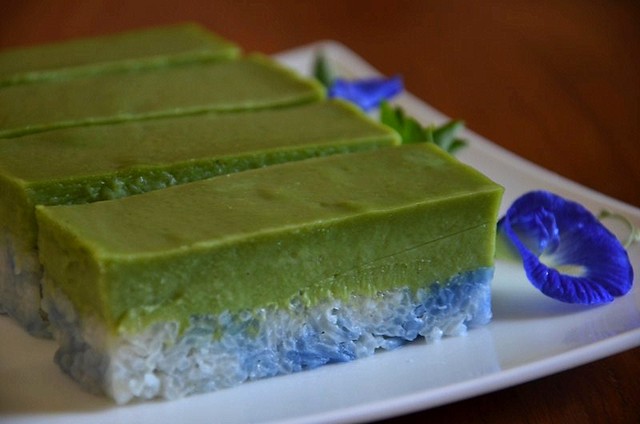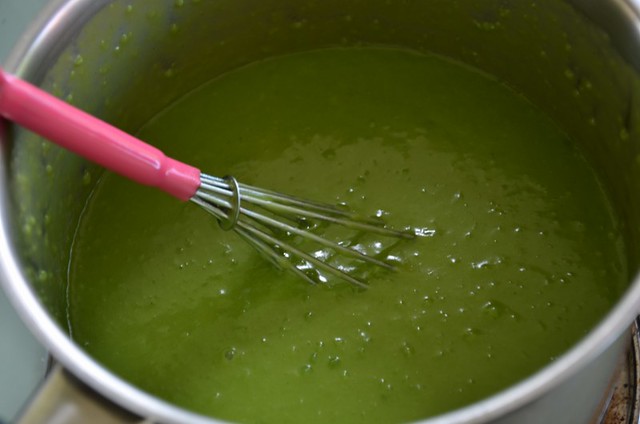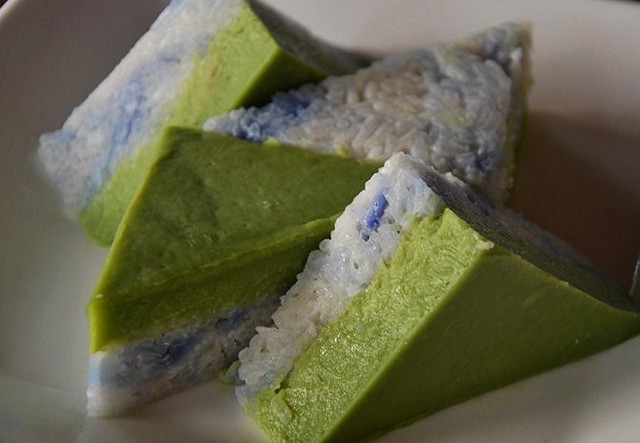
Traditionally, kuih serimukais green custard on top and white glutinous rice on the bottom but I've used blue pea flower to color the rice, making a nyonya kuih serimuka.
Kuih is a Malay word derived from the Fujian word kway for steamed 'cakes' made of flour (which can be wheat, rice, tapioca or glutinous rice), sugar and usually coconut milk. The flavoring is usually pandan leaves, an awesome ingredient largely unknown outside of South East Asia. Kuih are usually sweet but can also be savory. Economical to make or buy, kuih are eaten for breakfast and afternoon tea. I never buy the kuih from the markets because the rising cost of ingredients has resulted in tasteless kuih made of artificial coloring and cheap ingredients. Sometimes home-made kuih are sold on foldable makeshift tables outside grocery stores and those kuih are not good, but edible.
I found out recently that my son Wey loves kuih serimuka('pretty face kuih') and any kuih made with gula melaka. Gula melaka is palm sugar and if you haven't tasted it, pity. Regular white sugar has no flavor but gula melaka has this awesome flavor I can't describe. Anyway, the only kuih serimuka I liked, make that loved, was Aunty Teo's. Nobody's kuih serimuka could compare.For that reason, I seldom buy kuih serimuka and never made it either because I thought I'd never be able to make one as good as Aunty Teo's.
But being a martyr mother, I wanted to surprise my son when he came home from school so I decided to make kuih serimuka one day last week. There are lots of serimuka recipes onlinebut they couldn't be more different when it comes to the amount of liquid used to cook the rice. I didn't realize until after making my kuih that the amount of coconut milk used ! to cook the rice depends on whether the rice is pre-soaked or not. I also made the mistake of using a large square baking tin which didn't quite fit properly into my wok so it took an hour and a half to cook the rice instead of half an hour. Despite the struggle to get the rice cooked, the kuih serimuka turned out fabulous--smooth, delicious and wonderfullypandan and coconut flavored--and I think Aunty Teo would've agreed.
Last night, I came across this beautiful blog. Pickyin's photos and cakes are so beautiful that I looked at every one of her cakes. She styles her cakes the way I like: simple, tall and elegant. Do check her blog out! Oh, my point was this. Pickyin cooked her glutionous rice in an electric rice cooker instead of steaming it. Now why didn't I think of that.
Just remember this. For the best kuih, you must use quality ingredients. Don't be lazy or cheap. Use real pandan leaves, not color from the bottle. Get real gula melaka. You'll know when you taste it. Get freshly grated coconut. I go to the grocers and watch the guy grate my coconut. Then I come home and extract the coconut milk by hand. It has to be that fresh, and it makes all the difference. My son said my kuih serimuka is excellent, better than any he has eaten. Of course, I said, you're eating quality kuih my boy. In my unbiased opinion (haha), this kuih serimuka is even better than Teck Neo's.
My recipe is adapted from Nee. I've changed the proportion of flours to get a custard that is neither too chewy nor too soft (traditionally, the custard layer is soft).

Beautiful natural blue dye from the blue pea flower.

The blue color was so pretty I had to control myself from coloring all the rice blue.

From top to bottom: regular pandan leaves, new variety of miniature pandan leaves that are very strongly scented (I've since dug up and thrown away my regular pandan bushes) and leaves for coloring.

Okay, I think I had a bit too much chorophyll in the custard layer. The green color will deepen after the kuih cools, remember that.

Kuih Serimuka
Bottom Rice Layer
500 gm glutinous rice, washed & soaked 1 hour
500 ml thin coconut milk*
1 1/2 t salt
2 pandan leaves, roughed up by rubbing it with your hands (to release the flavor)
optional: 12 or more blue pea/bunga telang flowers
Note: *To make this, use 250 ml thick coconut milk and 250 ml thin coconut milk. This is a tip I took from Nasi Lemak's! recipe< /span>. Or use 200 ml thick and 300 ml thin coconut milk.I used about 900 gm grated coconut (from 1 1/2 coconuts) and added about 2 cups of water to make the thick milk, then added more water to the squeezed coconut to make the thin or 'second' coconut milk.
1. Drain the rice and put it into an electric rice cooker with the bruisedpandan leaves, salt and coconut milkand cook until done.
2. Make the blue dye by adding 3 tablespoons of boiling hot water to the flowers. Wait a minute, then crush the flowers with your hands and massage the color into the water.
3. Fluff the cooked rice and spoon into a lightly oiled 8"/20 cm square baking tin for higher slices of kuih or 11"/28cm square tin for kuih of about 1.5"/4 cm height.
4. Spoon the blue dye over the rice in random spots.Use a spoon or potato masher (the hand held one with holes) and press on the rice firmly, to compact and level it.Place the tin in a steamer, covered, and start the water boiling gently while you make the custard.
Top Custard Layer
800 ml thick coconut (400 ml thick + 400 ml thin coconut milk)
200 to 220 gm (I used 220) castor sugar
3 large eggs, beaten well
80 gm tapioca flour
50 gm plain flour
1 heaped T cornflour
6 to 7 pieces good pandan leaves + 6 pieces pandan color leaves*
Note: * Pickyin's tip on making pandan leaves. Cut the leaves into short sections (say 2"/5 cm long), blend or pound them until fine and add 3 to 5 tablespoons of water. Massage with your hands to release the color and strain through a fine seive. Let sit until the liquid separates into a top layer of dark green and a bottom layer of lighter green. Use the top layer only if you want a very thick and green custard, or add some of the second layer of pandan liquid.
5. Put the flours, sugar and coconut milk into a bowl, stirring until the sugar is mostly dissolved.
6. Add the eggs, stir well and strain through a sieve into a small pot.
7. Stir over very low heat until! mixture just thickens and turns shiny. Don't cook until custard is too thick or the texture won't be smooth.
8. Pour mixture over the rice, level by shaking the baking tin and steam 25 minutes over low heat. Cool completely (takes a couple of hours) before cuttinginto small rectangular or diamond or triangular pieceswith an oiled knife or wet knife. Kuih is best served at room temperature and is best eaten same day or within 24 hours.
No comments:
Post a Comment